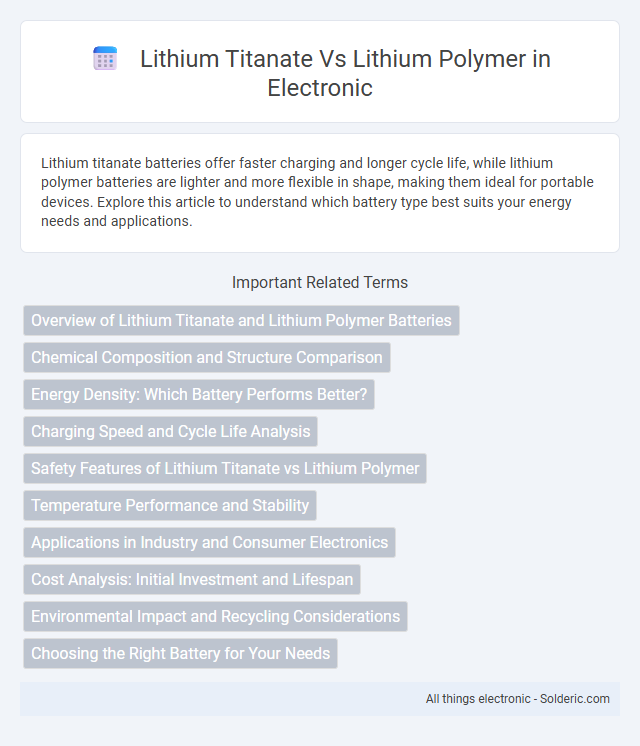Lithium titanate batteries offer faster charging and longer cycle life, while lithium polymer batteries are lighter and more flexible in shape, making them ideal for portable devices. Explore this article to understand which battery type best suits your energy needs and applications.
Comparison Table
| Feature | Lithium Titanate (LTO) | Lithium Polymer (LiPo) |
|---|---|---|
| Energy Density | Low (70-90 Wh/kg) | High (150-250 Wh/kg) |
| Charge Time | Very Fast (minutes) | Moderate (1-3 hours) |
| Cycle Life | Very High (up to 10,000 cycles) | Moderate (300-500 cycles) |
| Safety | High (stable, low risk of thermal runaway) | Moderate (flammable electrolyte, potential risk) |
| Cost | High | Lower |
| Applications | Electric buses, grid storage, fast charging | Consumer electronics, drones, electric vehicles |
Overview of Lithium Titanate and Lithium Polymer Batteries
Lithium titanate batteries feature rapid charging capabilities and excellent cycle life due to their stable anode material, while lithium polymer batteries provide flexibility in shape and lightweight design with high energy density. Your choice depends on whether fast recharge and longevity or lightweight and form adaptability are more critical for your application. Both battery types serve diverse markets, including electric vehicles, portable electronics, and renewable energy storage.
Chemical Composition and Structure Comparison
Lithium titanate (Li4Ti5O12) features a spinel crystal structure that enables rapid charge and discharge cycles with enhanced stability, while lithium polymer batteries use a lithium-ion chemistry with a polymer electrolyte, offering flexibility in shape and lightweight design. The lithium titanate anode's unique titanium oxide lattice significantly improves cycle life and thermal safety compared to the carbon-based anodes in lithium polymer cells. Structural differences result in lithium titanate batteries exhibiting lower energy density but superior durability and faster recharge capabilities relative to lithium polymer batteries.
Energy Density: Which Battery Performs Better?
Lithium polymer batteries generally offer higher energy density compared to lithium titanate batteries, making them more suitable for applications where compact size and longer run times are essential. Lithium titanate batteries excel in fast charging and longer cycle life but typically have lower energy density, resulting in heavier and bulkier battery packs. Your choice between the two depends on whether energy density or rapid charging capability is a priority for your device.
Charging Speed and Cycle Life Analysis
Lithium titanate batteries exhibit significantly faster charging speeds, achieving full charge in as little as 10-20 minutes due to their excellent lithium-ion diffusion rate and stable anode structure. In contrast, lithium polymer batteries typically require longer charging times, around 1 to 3 hours, because of their gel-like electrolyte and higher internal resistance. When analyzing cycle life, lithium titanate batteries excel with cycle counts exceeding 10,000 cycles, far surpassing lithium polymer batteries that generally last between 300 to 500 cycles, making lithium titanate ideal for applications demanding rapid recharge and long service life.
Safety Features of Lithium Titanate vs Lithium Polymer
Lithium titanate batteries offer enhanced safety features compared to lithium polymer batteries due to their stable spinel structure, which reduces the risk of thermal runaway and overheating. Unlike lithium polymer cells that can swell or catch fire under abuse or puncture, lithium titanate's robust chemistry allows for faster charging and safer operation in extreme conditions. You can rely on lithium titanate batteries for applications requiring high durability and superior safety margins.
Temperature Performance and Stability
Lithium titanate batteries exhibit superior temperature performance with a wide operating range from -30degC to 55degC, maintaining stable capacity and fast charging abilities even in extreme cold or heat. Lithium polymer batteries, while lighter and more flexible in shape, typically operate best between 0degC and 45degC, with performance and stability decreasing notably outside this range. The enhanced thermal stability of lithium titanate cells reduces the risk of thermal runaway, making them safer and more reliable for high-temperature or demanding environmental conditions.
Applications in Industry and Consumer Electronics
Lithium titanate batteries excel in industrial applications requiring rapid charge and discharge cycles, such as electric buses, grid energy storage, and military equipment due to their long cycle life and high safety. Lithium polymer batteries dominate consumer electronics, including smartphones, laptops, and wearable devices, because of their lightweight, flexible form factor, and high energy density. Industrial sectors favor lithium titanate for durability and stability, while portable electronics benefit from lithium polymer's versatility and compact design.
Cost Analysis: Initial Investment and Lifespan
Lithium titanate batteries generally have a higher initial cost compared to lithium polymer batteries due to their advanced materials and manufacturing processes. However, lithium titanate offers a significantly longer lifespan, often exceeding 10,000 charge cycles, which can lower the total cost of ownership over time. Your decision should factor in the balance between upfront investment and the extended durability lithium titanate provides for high-performance applications.
Environmental Impact and Recycling Considerations
Lithium titanate batteries offer a longer lifespan and higher safety profile, which reduces environmental waste compared to lithium polymer batteries that often require more frequent replacement. The recycling process for lithium titanate is more straightforward due to its stable chemical structure, enabling better recovery of valuable materials and minimizing toxic emissions. Choosing lithium titanate can enhance your environmental footprint by supporting more sustainable battery usage and improved end-of-life management.
Choosing the Right Battery for Your Needs
Selecting the right battery depends on specific use cases, where lithium titanate batteries offer exceptional cycle life, rapid charging, and higher safety for applications demanding durability and fast recharge, such as electric vehicles and grid storage. Lithium polymer batteries provide higher energy density, lighter weight, and flexible shapes, making them ideal for portable electronics, drones, and smartphones where compact design and longer runtime are priorities. Understanding the trade-offs between longevity and energy density ensures optimal performance tailored to your device's power requirements and operating conditions.
Lithium titanate vs lithium polymer Infographic

 solderic.com
solderic.com